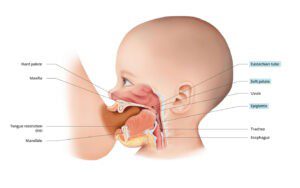THE TREMENDOUS TONGUE
THE TONGUE.
It is such an intricate and unique part of the human body. It is definitely the most interesting of all of the body’s muscles, and it’s been described as the most misunderstood muscle as well. The tongue plays a leading role in speech, eating (mastication and taste), facial expressions, and sexual arousal.
Most animals groom themselves or their loved ones with their tongues. A simple act of sticking out one’s tongue can indicate thoughtfulness or disgust. It has an incredibly complex range of motion. In the world of Breastfeeding, the tongue is the subject of endless discussions and debates for several reasons.

Let’s set the stage with some “tremendous tongue” Anatomy.
The tongue comprises eight different muscles that allow it to move in all the needed ranges of motion for feeding and speaking. Those muscles are:
Genioglossus– the main action is a protrusion (sticking the tongue out).
Styloglossus– retraction and elevation of the tongue
Hyoglossus– retraction and depression of the tongue
Palatoglossus– elevates the posterior portion of the tongue and aids in swallowing
Superior and Inferior Longitudinal – work together to retract the tongue
The Vertical- flattens and broadens the tongue
The Transverse- makes the tongue narrow and elongated
These muscles originate and are attached to various cranial and spinal bones. The primary attachment sites are the Temporal bones (“Stylo” refers to a protrusion on the underside of the Temporal bone called the styloid process), the Mandible, and the Hyoid bone in the upper neck.
This relatively small muscle is also a vast network of arteries, veins, nerves, lymphatic and salivary vessels. The average person has over 10,000 tastebuds (less when we’re older) which are replaced approximately every 2 days. The primary nerve supply is Cranial Nerve XII, the Hypoglossal Nerve. It originates in the brainstem and exits the skull at the Hypoglossal ‘Canal located in the medial portion of the Occipital condyles (right between the Occiput and the first cervical vertebra).
Now… Let’s relate this discussion to our favorite subject: Breastfeeding. Why is this small yet intricate muscle the topic of such conversation in the breastfeeding communities? Well… a few things need to happen for you and your baby to breastfeed normally:
Your baby must have a normal latch.
Your baby must be able to open their mouth wide enough to get much of your areola into the mouth. The milk ducts are deep within this breast tissue. If the baby has a shallow latch (and cannot open the mouth widely), the milk transfer will be much harder, and nursing will likely be painful for you.
Your baby must have the normal use of his tongue.
Your baby must have the strength to squeeze your breast tissue tightly to the roof of his mouth to create a vacuum seal and suction pressure to transfer milk. Your baby also must have the normal range of motion of his tongue to do this. If your baby has either a weak or restricted tongue (or both), then he likely can’t drain the breast completely. You might become painfully engorged, leading to mastitis. You might also have a low milk supply as he cannot stimulate enough production. This can be a complicated topic. Some possible barriers can prevent normal tongue function.
Because tongue muscles are attached to the bony structures of the cranium and the spine, when this structure is imbalanced, the muscles become pulled and strained. When this happens under the tongue, possibly due to upper cervical and Hyoid bone imbalance, this can tether the tongue to the bottom of the mouth.

Most of us are familiar with the terms Ankyloglossia or “tongue-tie .”This is when the band of tissue under the tongue, called the frenulum, is genetically shortened or tethered. These ties can also occur under the upper lip or between the cheek and gums. Oral ties have been diagnosed in much greater numbers in the past decade.
This is thought to be a “midline defect,” forming during embryonic development due to a genetic mutation of the gene MTHFR (Methylenetetrahydrofolate Reductase) that helps process folate.
In the case of true genetic tethering, your baby may need to have a surgical release of these tissues, often performed by a pediatrician, an ENT doctor, or a specialized Pediatric dentist with scissors or a laser. Often, however, the structural tethering of the tongue due to cranial and spinal imbalance can be misdiagnosed as Ankyloglossia.
It is also common that both conditions exist at the same time. In either case, addressing the structural imbalance is crucial for restoring normal function.
Another reason that your baby might not be able to use their tongue normally is any impingement to the Hypoglossal nerve as it exits the canal located deep within the base of the skull and travels through the upper neck. Misalignment of these areas, often caused by the birth process, can cause unhealthy tension and result in weak muscles of the tongue.
One last detail to normal tongue function is the shape of your baby’s palate. As I mentioned earlier, your baby must have the strength to squeeze your breast tissue tightly to the roof of his mouth to create a vacuum seal and suction pressure to transfer milk. Sometimes, the palate is higher than normal, making it even harder for the tongue to do its job. The shape of the palate is formed in two ways:
The alignment of the cranial bones that form the palate- The Maxilla and the Palatine bones AND the other structures attached to (the Sphenoid, the Jaw, etc.).
The arch of the palate is also formed by the tongue pressing up against it during fetal development. If the tongue does not have a normal range of motion (for all of the reasons discussed above), there can be an abnormal palate development. Even as your baby grows, the tongue still plays a role in the normal alignment of the palate, bringing this all full circle.
A LOT is going on in this small organ in our mouths!
If you and your baby are struggling to breastfeed, getting help from a qualified Lactation consultant can be very helpful. One of the very first things to examine will be if your baby has the normal function of the tongue. If not, getting help from a specially trained Pediatric chiropractor to address cranial and spinal imbalance is a crucial part of the care plan to restore this function. There is help available!
To learn more about breastfeeding and the anatomy involved in infants and how it affects breastfeeding, real-life case studies with breastfeeding patients, a host of interviews with lactation consultants, diagrams, demonstrations, and visual examples to teach the global subluxation pattern – The Anatomy of Breastfeeding. This new, updated, accredited continuing education course is for Chiropractors who are looking to improve their careers, learn from leaders and experts in their industry, and looking for new opportunities! The course is approved for 10 CE hours.
“Breastfeeding is not just a method of delivering nutrition; it’s also a way of establishing a relationship, requiring a sensitive dialogue between mother and infant… they learn to trust each other and to feel confident of each other’s love… This is baby’s first relationship in life and one that sets the tone for how baby learns to view the world.”
The Breastfeeding Book”, Martha Sears RN and William Sears, MD. Little Brown and Co., 2000.
It is so worth it. There is help available.
Types of courses
For Chiropractors and Bodyworkers

Learn to identify cranial, spinal, muscular and dural imbalances relating to breastfeeding as well as how to specifically address them. Gain current research to validate your work. Become familiar with the scope of other birth professionals in order to collaborate, gain referrals and provide the overall best care for your clients.
For Lactation Consultants and Birth Professionals

Learn specific infant anatomy in order to understand why your patient’s baby is struggling. Learn about the long term physical, emotional, and neurological implications of these issues. Become familiar with the scope of bodyworkers in order to provide the best support for your clients. Gain evidence based research to support your instincts.
For Breastfeeding
Parents

Gain resources to help you successfully breastfeed your baby without pain or struggle. Learn WHY breastfeeding is best. Why are you doing this? Understand how the alignment and
tone of your child’s body effects her development and long term health;
both neurologically and
emotionally.

